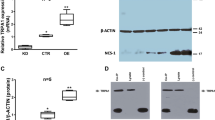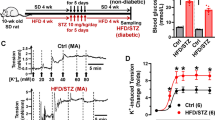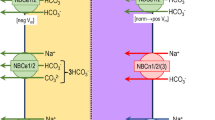Abstract
Polycystic kidney disease 2-like-1 (PKD2L1), or polycystin-L or TRPP2, formerly TRPP3, is a transient receptor potential (TRP) superfamily member. It is a calcium-permeable non-selective cation channel that regulates intracellular calcium concentration and thereby calcium signaling. PKD2L1 has been reported to take part in hedgehog signaling in renal primary cilia and sour tasting coupling with PKD1L3. In addition to the previous reports, PKD2L1 is recently found to play a crucial role in localization with β2-adrenergic receptor (β2AR) on the neuronal primary cilia. The disruption of PKD2L1 leads to the loss of β2AR on the primary cilia and reduction in intracellular concentration of cyclic adenosine monophosphate (cAMP). Since the role of cAMP and PKA is frequently mentioned in the studies of PKD diseases, we investigated on the mechanism of cAMP regulation in relation to the function of PKD2L1 channel. In this study, we observed the activity of PKD2L1 channel increased by the downstream cascades of β2AR and found the clustered phosphorylation sites, Ser-682, Ser-685, and Ser-686 that are significant in the channel regulation by phosphorylation.







Similar content being viewed by others
Abbreviations
- AC:
-
adenylate cyclase
- ADPKD:
-
autosomal dominant polycystic kidney disease
- AR:
-
adrenergic receptor
- cAMP:
-
cyclic adenosine monophosphate
- CMZ:
-
calmidazolium
- FSK:
-
forskolin
- ISO:
-
isoproterenol
- PKA:
-
protein kinase A
- PKD2L1:
-
polycystic kidney disease 2-like-1
- TRP:
-
transient receptor potential
References
Atwood BK, Lopez J, Wager-Miller J, Mackie K, Straiker A (2011) Expression of G protein-coupled receptors and related proteins in HEK293, AtT20, BV2, and N18 cell lines as revealed by microarray analysis. BMC Genomics 12(1):14. https://doi.org/10.1186/1471-2164-12-14
Besschetnova TY, Kolpakova-Hart E, Guan Y, Zhou J, Olsen BR, Shah JV (2010) Identification of signaling pathways regulating primary cilium length and flow-mediated adaptation. Curr Biol 20(2):182–187. https://doi.org/10.1016/j.cub.2009.11.072
Cai Y, Anyatonwu G, Okuhara D, Lee KB, Yu Z, Onoe T, Mei CL, Qian Q, Geng L, Wiztgall R, Ehrlich BE, Somlo S (2004) Calcium dependence of polycystin-2 channel activity is modulated by phosphorylation at Ser812. J Biol Chem 279(19):19987–19995. https://doi.org/10.1074/jbc.M312031200
Cai Y, Maeda Y, Cedzich A, Torres VE, Wu G, Hayashi T, Mochizuki T, Park JH, Witzgall R, Somlo S (1999) Identification and characterization of polycystin-2, the PKD2 gene product. J Biol Chem 274(40):28557–28565. https://doi.org/10.1074/jbc.274.40.28557
Cantero Mdel R, Velazquez IF, Streets AJ, Ong AC, Cantiello HF (2015) The cAMP signaling pathway and direct protein kinase a phosphorylation regulate Polycystin-2 (TRPP2) channel function. J Biol Chem 290(39):23888–23896. https://doi.org/10.1074/jbc.M115.661082
Chen X-Z, Vassilev PM, Basora N, Peng J-B, Nomura H, Segal Y, Brown EM, Reeders ST, Hediger MA, Zhou J (1999) Polycystin-L is a calcium-regulated cation channel permeable to calcium ions. Nature 401(6751):383–386. https://doi.org/10.1038/43907
Chen XZ, Segal Y, Basora N, Guo L, Peng JB, Babakhanlou H, Vassilev PM, Brown EM, Hediger MA, Zhou J (2001) Transport function of the naturally occurring pathogenic polycystin-2 mutant, R742X. Biochem Biophys Res Commun 282(5):1251–1256. https://doi.org/10.1006/bbrc.2001.4720
Chijiwa T, Mishima A, Hagiwara M, Sano M, Hayashi K, Inoue T, Naito K, Toshioka T, Hidaka H (1990) Inhibition of forskolin-induced neurite outgrowth and protein phosphorylation by a newly synthesized selective inhibitor of cyclic AMP-dependent protein kinase, N-[2-(p-bromocinnamylamino)ethyl]-5-isoquinolinesulfonamide (H-89), of PC12D pheochromocytoma cells. J Biol Chem 265(9):5267–5272
Choi J, Choi BH, Hahn SJ, Yoon SH, Min DS, Jo Y, Kim M (2001) Inhibition of Kv1.3 channels by H-89 (N--[2-(p-bromocinnamylamino)ethyl]-5-isoquinolinesulfonamide) independent of protein kinase A. Biochem Pharmacol 61(8):1029–1032. https://doi.org/10.1016/S0006-2952(01)00556-1
Choi YH, Suzuki A, Hajarnis S, Ma Z, Chapin HC, Caplan MJ, Pontoglio M, Somlo S, Igarashi P (2011) Polycystin-2 and phosphodiesterase 4C are components of a ciliary A-kinase anchoring protein complex that is disrupted in cystic kidney diseases. Proc Natl Acad Sci U S A 108(26):10679–10684. https://doi.org/10.1073/pnas.1016214108
Dalton GD, Dewey WL (2006) Protein kinase inhibitor peptide (PKI): a family of endogenous neuropeptides that modulate neuronal cAMP-dependent protein kinase function. Neuropeptides 40(1):23–34. https://doi.org/10.1016/j.npep.2005.10.002
Davies SP, Reddy H, Caivano M, Cohen P (2000) Specificity and mechanism of action of some commonly used protein kinase inhibitors. Biochem J 351(1):95–105. https://doi.org/10.1042/bj3510095
DeCaen PG, Delling M, Vien TN, Clapham DE (2013) Direct recording and molecular identification of the calcium channel of primary cilia. Nature 504(7479):315–318. https://doi.org/10.1038/nature12832
DeCaen PG, Liu X, Abiria S, Clapham DE (2016) Atypical calcium regulation of the PKD2-L1 polycystin ion channel. Elife 5:https://doi.org/10.7554/eLife.13413
Delling M, DeCaen PG, Doerner JF, Febvay S, Clapham DE (2013) Primary cilia are specialized calcium signalling organelles. Nature 504(7479):311–314. https://doi.org/10.1038/nature12833
Glass DB, Cheng HC, Mende-Mueller L, Reed J, Walsh DA (1989) Primary structural determinants essential for potent inhibition of cAMP-dependent protein kinase by inhibitory peptides corresponding to the active portion of the heat-stable inhibitor protein. J Biol Chem 264(15):8802–8810
Gonzalez-Perrett S, Kim K, Ibarra C, Damiano AE, Zotta E, Batelli M, Harris PC, Reisin IL, Arnaout MA, Cantiello HF (2001) Polycystin-2, the protein mutated in autosomal dominant polycystic kidney disease (ADPKD), is a Ca2+−permeable nonselective cation channel. Proc Natl Acad Sci U S A 98(3):1182–1187. https://doi.org/10.1073/pnas.98.3.1182
Gorojankina T (2016) Hedgehog signaling pathway: a novel model and molecular mechanisms of signal transduction. Cell Mol Life Sci 73(7):1317–1332. https://doi.org/10.1007/s00018-015-2127-4
Hopp K, Ward CJ, Hommerding CJ, Nasr SH, Tuan HF, Gainullin VG, Rossetti S, Torres VE, Harris PC (2012) Functional polycystin-1 dosage governs autosomal dominant polycystic kidney disease severity. J Clin Invest 122(11):4257–4273. https://doi.org/10.1172/JCI64313
Hruz T, Laule O, Szabo G, Wessendorp F, Bleuler S, Oertle L, Widmayer P, Gruissem W, Zimmermann P (2008) Genevestigator v3: a reference expression database for the meta-analysis of transcriptomes. Adv Bioinforma 2008:420747–420745. https://doi.org/10.1155/2008/420747
Jacob LS, Wu X, Dodge ME, Fan CW, Kulak O, Chen B, Tang W, Wang B, Amatruda JF, Lum L (2011) Genome-wide RNAi screen reveals disease-associated genes that are common to hedgehog and Wnt signaling. Sci signal 4:ra4. https://doi.org/10.1126/scisignal.2001225
Keady BT, Samtani R, Tobita K, Tsuchya M, San Agustin JT, Follit JA, Jonassen JA, Subramanian R, Lo CW, Pazour GJ (2012) IFT25 links the signal-dependent movement of hedgehog components to intraflagellar transport. Dev Cell 22(5):940–951. https://doi.org/10.1016/j.devcel.2012.04.009
Koulen P, Cai Y, Geng L, Maeda Y, Nishimura S, Witzgall R, Ehrlich BE, Somlo S (2002) Polycystin-2 is an intracellular calcium release channel. Nat Cell Biol 4(3):191–197. https://doi.org/10.1038/ncb754
Lahouratate P, Guibert J, Camelin JC, Bertrand I (1997) Specific inhibition of cardiac and skeletal muscle sarcoplasmic reticulum Ca2+ pumps by H-89. Biochem Pharmacol 54(9):991–998. https://doi.org/10.1016/S0006-2952(97)00320-1
Lee RT, Zhao Z, Ingham PW (2016) Hedgehog signalling. Development 143(3):367–372. https://doi.org/10.1242/dev.120154
Leemhuis J, Boutillier S, Schmidt G, Meyer DK (2002) The protein kinase a inhibitor H89 acts on cell morphology by inhibiting rho kinase. J Pharmacol Exp Ther 300(3):1000–1007. https://doi.org/10.1124/jpet.300.3.1000
Li M, Wang X, Meintzer MK, Laessig T, Birnbaum MJ, Heidenreich KA (2000) Cyclic AMP promotes neuronal survival by phosphorylation of glycogen synthase kinase 3beta. Mol Cell Biol 20(24):9356–9363. https://doi.org/10.1128/MCB.20.24.9356-9363.2000
Liao Z, Lockhead D, Larson ED, Proenza C (2010) Phosphorylation and modulation of hyperpolarization-activated HCN4 channels by protein kinase a in the mouse sinoatrial node. J Gen Physiol 136(3):247–258. https://doi.org/10.1085/jgp.201010488
Lochner A, Moolman JA (2006) The many faces of H89: a review. Cardiovasc Drug Rev 24(3-4):261–274. https://doi.org/10.1111/j.1527-3466.2006.00261.x
Martin V, Shaw-Smith C (2010) Review of genetic factors in intestinal malrotation. Pediatr Surg Int 26(8):769–781. https://doi.org/10.1007/s00383-010-2622-5
Mick DU, Rodrigues RB, Leib RD, Adams CM, Chien AS, Gygi SP, Nachury MV (2015) Proteomics of primary cilia by proximity labeling. Dev Cell 35(4):497–512. https://doi.org/10.1016/j.devcel.2015.10.015
Numazaki M, Tominaga T, Takeuchi K, Murayama N, Toyooka H, Tominaga M (2003) Structural determinant of TRPV1 desensitization interacts with calmodulin. Proc Natl Acad Sci U S A 100(13):8002–8006. https://doi.org/10.1073/pnas.1337252100
Ramalho-Santos M, Melton DA, McMahon AP (2000) Hedgehog signals regulate multiple aspects of gastrointestinal development. Development 127(12):2763–2772
Rees S, Kittikulsuth W, Roos K, Strait KA, Van Hoek A, Kohan DE (2014) Adenylyl cyclase 6 deficiency ameliorates polycystic kidney disease. J Am Soc Nephrol 25(2):232–237. https://doi.org/10.1681/ASN.2013010077
Rosenbaum T, Gordon-Shaag A, Munari M, Gordon SE (2004) Ca2+/calmodulin modulates TRPV1 activation by capsaicin. J Gen Physiol 123(1):53–62. https://doi.org/10.1085/jgp.200308906
Shen PS, Yang X, DeCaen PG, Liu X, Bulkley D, Clapham DE, Cao E (2016) The structure of the polycystic kidney disease channel PKD2 in lipid nanodiscs. Cell 167:763–773.e11. https://doi.org/10.1016/j.cell.2016.09.048
Shimizu T, Janssens A, Voets T, Nilius B (2009) Regulation of the murine TRPP3 channel by voltage, pH, and changes in cell volume. Pflugers Arch 457(4):795–807. https://doi.org/10.1007/s00424-008-0558-6
Shoshan MC, Ljungdahl S, Linder S (1996) H-89 inhibits collagenase induction by phorbol ester through a mechanism that does not involve protein kinase a. Cell Signal 8(3):191–195. https://doi.org/10.1016/0898-6568(95)02054-3
Son YK, Park WS, Kim SJ, Earm YE, Kim N, Youm JB, Warda M, Kim E, Han J (2006) Direct inhibition of a PKA inhibitor, H-89 on KV channels in rabbit coronary arterial smooth muscle cells. Biochem Biophys Res Commun 341(4):931–937. https://doi.org/10.1016/j.bbrc.2006.01.053
Streets AJ, Moon DJ, Kane ME, Obara T, Ong AC (2006) Identification of an N-terminal glycogen synthase kinase 3 phosphorylation site which regulates the functional localization of polycystin-2 in vivo and in vitro. Hum Mol Genet 15(9):1465–1473. https://doi.org/10.1093/hmg/ddl070
Streets AJ, Wessely O, Peters DJ, Ong AC (2013) Hyperphosphorylation of polycystin-2 at a critical residue in disease reveals an essential role for polycystin-1-regulated dephosphorylation. Hum Mol Genet 22(10):1924–1939. https://doi.org/10.1093/hmg/ddt031
Sunagawa M, Kosugi T, Nakamura M, Sperelakis N (2000) Pharmacological actions of calmidazolium, a calmodulin antagonist, in cardiovascular system. Cardiovasc Drug Rev 18:211–221
Sussman CR, Ward CJ, Leightner AC, Smith JL, Agarwal R, Harris PC, Torres VE (2014) Phosphodiesterase 1A modulates cystogenesis in zebrafish. J Am Soc Nephrol 25(10):2222–2230. https://doi.org/10.1681/ASN.2013040421
Taurin S, Sandbo N, Qin Y, Browning D, Dulin NO (2006) Phosphorylation of beta-catenin by cyclic AMP-dependent protein kinase. J Biol Chem 281(15):9971–9976. https://doi.org/10.1074/jbc.M508778200
Torres VE, Harris PC (2014) Strategies targeting cAMP signaling in the treatment of polycystic kidney disease. J Am Soc Nephrol 25(1):18–32. https://doi.org/10.1681/ASN.2013040398
Vassilev PM, Guo L, Chen XZ, Segal Y, Peng JB, Basora N, Babakhanlou H, Cruger G, Kanazirska M, Ye C, Brown EM, Hediger MA, Zhou J (2001) Polycystin-2 is a novel cation channel implicated in defective intracellular Ca(2+) homeostasis in polycystic kidney disease. Biochem Biophys Res Commun 282(1):341–350. https://doi.org/10.1006/bbrc.2001.4554
Wieprecht M, Wieder T, Geilen CC (1994) N-[2-bromocinnamyl(amino)ethyl]-5-isoquinolinesulphonamide (H-89) inhibits incorporation of choline into phosphatidylcholine via inhibition of choline kinase and has no effect on the phosphorylation of CTP: phosphocholine cytidylyltransferase. Biochem J 297(Pt 1):241–247. https://doi.org/10.1042/bj2970241
Yamaguchi T, Hempson SJ, Reif GA, Hedge AM, Wallace DP (2006) Calcium restores a normal proliferation phenotype in human polycystic kidney disease epithelial cells. J Am Soc Nephrol 17(1):178–187. https://doi.org/10.1681/ASN.2005060645
Yamaguchi T, Wallace DP, Magenheimer BS, Hempson SJ, Grantham JJ, Calvet JP (2004) Calcium restriction allows cAMP activation of the B-Raf/ERK pathway, switching cells to a cAMP-dependent growth-stimulated phenotype. J Biol Chem 279(39):40419–40430. https://doi.org/10.1074/jbc.M405079200
Yao G, Luo C, Harvey M, Wu M, Schreiber TH, Du Y, Basora N, Su X, Contreras D, Zhou J (2016) Disruption of polycystin-L causes hippocampal and thalamocortical hyperexcitability. Hum Mol Genet 25(3):448–458. https://doi.org/10.1093/hmg/ddv484
Ye H, Wang X, Constans MM, Sussman CR, Chebib F, Irazabal MV, Young WF Jr, Harris PC, Kirschner LS, Torres VE (2017) The regulatory 1alpha subunit of protein kinase a modulates renal cystogenesis. Am J Physiol Renal Physiol:ajprenal 00119(3):2017–F686. https://doi.org/10.1152/ajprenal.00119.2017
Ye H, Wang X, Sussman CR, Hopp K, Irazabal MV, Bakeberg JL, LaRiviere WB, Manganiello VC, Vorhees CV, Zhao H, Harris PC, van Deursen J, Ward CJ, Torres VE (2016) Modulation of polycystic kidney disease severity by phosphodiesterase 1 and 3 subfamilies. J Am Soc Nephrol 27(5):1312–1320. https://doi.org/10.1681/ASN.2015010057
Zhang M, Mahoney E, Zuo T, Manchanda PK, Davuluri RV, Kirschner LS (2014) Protein kinase A activation enhances beta-catenin transcriptional activity through nuclear localization to PML bodies. PLoS One 9(10):e109523. https://doi.org/10.1371/journal.pone.0109523
Zheng W, Yang J, Beauchamp E, Cai R, Hussein S, Hofmann L, Li Q, Flockerzi V, Berthiaume LG, Tang J, Chen XZ (2016) Regulation of TRPP3 channel function by N-terminal domain palmitoylation and phosphorylation. J Biol Chem 291(49):25678–25691. https://doi.org/10.1074/jbc.M116.756544
Zhu MX (2005) Multiple roles of calmodulin and other ca(2+)-binding proteins in the functional regulation of TRP channels. Pflugers Arch 451(1):105–115. https://doi.org/10.1007/s00424-005-1427-1
Acknowledgments
We thank Dr. Markus Delling (UCSF) for kindly donating human PKD2L1 construct. This research project was supported by the BK21-plus education program of the MOE (Ministry of Education), Korea by the National Research Foundation of Korea, and Mid-career Researcher Program through NRF grant funded by the Korea government (Minstry of Science and ICT) (2015R1A2A1A05001756).
Author information
Authors and Affiliations
Corresponding author
Ethics declarations
Conflict of interest
The authors declare that they have no conflict of interest.
Electronic supplementary material
ESM 1
Supplementary Fig. 1 The potentiation and inactivation of the channel by different concentrations of the intracellular free calcium. a A full current trace of PKD2L1 measured under 16 nM free calcium condition in a PKD2L1 expressed HEK293 cell using whole-cell patch clamp technique. From the holding potential at − 60 mV, ramp pulse was applied from − 100 to 100 mV. b A full current trace of PKD2L1 measured under 100 nM free calcium condition in a PKD2L1 expressed HEK293. c The I-V relationship of PKD2L1. Each colored line indicates I-V relationship at the basal current amplitude (black), the peak amplitude in 16 nM free calcium condition (blue), and the peak amplitude in 100 nM free calcium condition (purple). Supplementary Fig. 2 Endogenous channel current in HEK293 cell. a A full current trace of HEK293 cell with b 1 μM CMZ, and c 100 μM ISO application. d A full current trace of HEK293 transfected with Gαs (Q227L). e A full current trace of HEK293 cell with 100 μM FSK and f 100 μM cAMP application. Supplementary Fig. 3 A summarized basal current amplitude of PKD2L1WT and PKD2L1 mutants. a A summarized basal current amplitude of PKD2L1 single mutants. b A summarized basal current amplitude of PKD2L1 double mutants. c A summarized basal current amplitude of PKD2L1 clustered mutants. *p < 0.05, **p < 0.01, ***p < 0.001. Supplementary Fig. 4 Double mutants activated by 1 μM CMZ and 100 nM free calcium solution a A full current trace of PKD2L1(S581A/S747A), b PKD2L1(S747A/S805A), and c PKD2L1(S581A/S805A) activated by 1 μM CMZ. d A summarized increased current amplitude of double mutants induced by 1 μM CMZ. e A full current trace of PKD2L1(S581A/S747A), f PKD2L1(S747A/S805A), and g PKD2L1(S581A/S805A) activated by 100 nM free calcium concentration. h A summarized peak current amplitude of double mutants induced by 100 nM free calcium concentration. Supplementary Fig. 5 The consistent surface expression level of PKD2L1WT and the double mutants. a Representative surface expression level of PKD2L1 and three double mutants. (PDF 1242 kb)
Rights and permissions
About this article
Cite this article
Park, E.Y.J., Kwak, M., Ha, K. et al. Identification of clustered phosphorylation sites in PKD2L1: how PKD2L1 channel activation is regulated by cyclic adenosine monophosphate signaling pathway. Pflugers Arch - Eur J Physiol 470, 505–516 (2018). https://doi.org/10.1007/s00424-017-2095-7
Received:
Revised:
Accepted:
Published:
Issue Date:
DOI: https://doi.org/10.1007/s00424-017-2095-7




